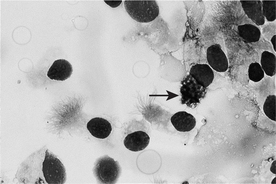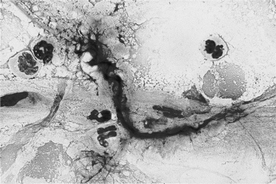45 TRANSTRACHEAL WASH AND BRONCHOALVEOLAR LAVAGE
2 What are the common findings on TTW/BAL from normal animals?
Washes from normal animals typically consist primarily of alveolar macrophages. In TTW, ciliated columnar epithelial cells are often present in moderate to high numbers (Figure 45-1). Cuboidal epithelial cells may also be observed. Small lymphocytes are present in variable numbers (low to moderate) with BAL. A small amount of mucus may be present. Some red blood cells (RBCs) may be present as well as occasional neutrophils, eosinophils, lymphocytes, and mast cells. Also, rare goblet cells may be observed.
3 List the common cytologic interpretations from TTW/BAL.
An insufficient sample means no cells or an inadequate number of cells for evaluation.
4 What are goblet cells, and how are they recognized?
Goblet cells are mucus-producing cells. They are epithelial cells that are generally columnar in shape with a basally placed nucleus and medium-sized, roundish, intracytoplasmic granules of mucus (see Figure 45-1). Occasionally the granules will distend the cytoplasm so greatly that the cell may appear round. The granules may stain red, blue, or clear with various stains. Goblet cell numbers may increase secondary to any chronic airway irritant.
5 What are Curschmann spirals?
Curschmann spirals are mucous casts of small bronchioles. They appear as spiral, twisted masses of mucus that may have perpendicular radiations, giving the spirals a “test tube brush–like” appearance (Figure 45-2). Curschmann spirals may be found with any disease or disorder that results in chronic, excessive production of mucus.
Stay updated, free articles. Join our Telegram channel

Full access? Get Clinical Tree




